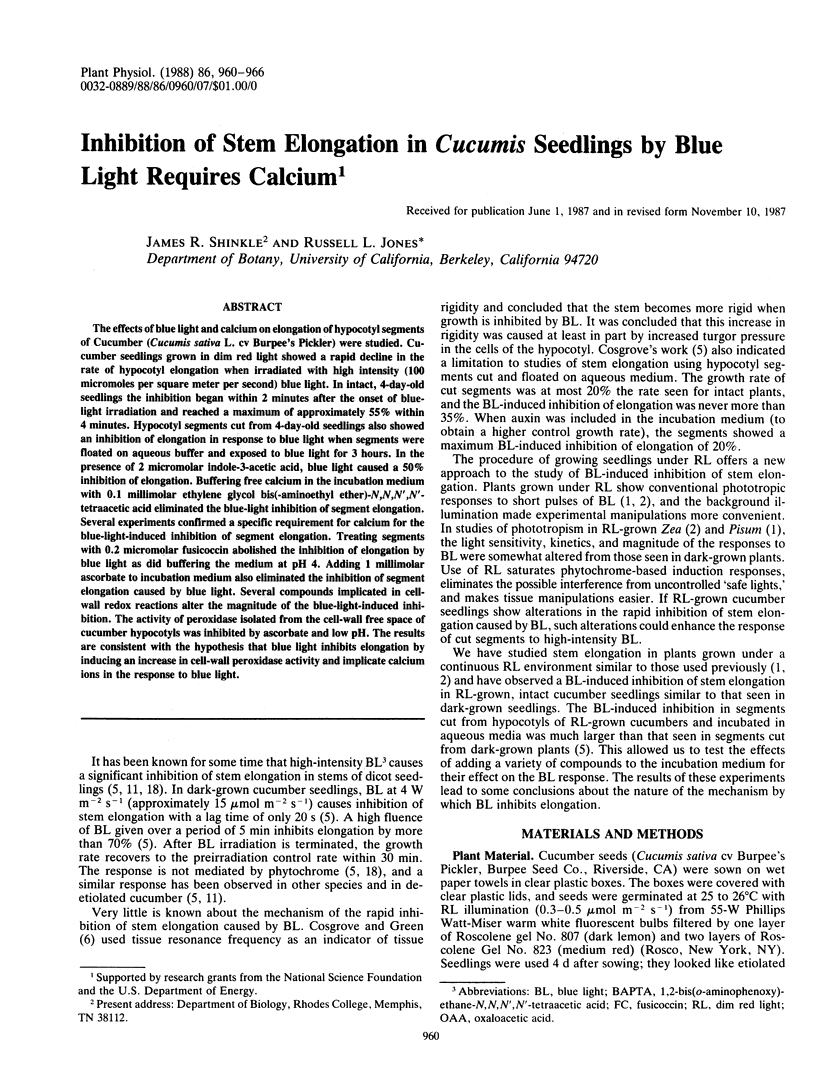Abstract
The effects of blue light and calcium on elongation of hypocotyl segments of Cucumber (Cucumis sativa L. cv Burpee's Pickler) were studied. Cucumber seedlings grown in dim red light showed a rapid decline in the rate of hypocotyl elongation when irradiated with high intensity (100 micromoles per square meter per second) blue light. In intact, 4-day-old seedlings the inhibition began within 2 minutes after the onset of blue-light irradiation and reached a maximum of approximately 55% within 4 minutes. Hypocotyl segments cut from 4-day-old seedlings also showed an inhibition of elongation in response to blue light when segments were floated on aqueous buffer and exposed to blue light for 3 hours. In the presence of 2 micromolar indole-3-acetic acid, blue light caused a 50% inhibition of elongation. Buffering free calcium in the incubation medium with 0.1 millimolar ethylene glycol bis(-aminoethyl ether)- N,N,N′,N′-tetraacetic acid eliminated the blue-light inhibition of segment elongation. Several experiments confirmed a specific requirement for calcium for the blue-light-induced inhibition of segment elongation. Treating segments with 0.2 micromolar fusicoccin abolished the inhibition of elongation by blue light as did buffering the medium at pH 4. Adding 1 millimolar ascorbate to incubation medium also eliminated the inhibition of segment elongation caused by blue light. Several compounds implicated in cell-wall redox reactions alter the magnitude of the blue-light-induced inhibition. The activity of peroxidase isolated from the cell-wall free space of cucumber hypocotyls was inhibited by ascorbate and low pH. The results are consistent with the hypothesis that blue light inhibits elongation by inducing an increase in cell-wall peroxidase activity and implicate calcium ions in the response to blue light.
Full text
PDF






Selected References
These references are in PubMed. This may not be the complete list of references from this article.
- Cleland R. E. Kinetics of Hormone-induced H Excretion. Plant Physiol. 1976 Aug;58(2):210–213. doi: 10.1104/pp.58.2.210. [DOI] [PMC free article] [PubMed] [Google Scholar]
- Cosgrove D. J., Green P. B. Rapid Suppression of Growth by Blue Light : BIOPHYSICAL MECHANISM OF ACTION. Plant Physiol. 1981 Dec;68(6):1447–1453. doi: 10.1104/pp.68.6.1447. [DOI] [PMC free article] [PubMed] [Google Scholar]
- McNeil M., Darvill A. G., Fry S. C., Albersheim P. Structure and function of the primary cell walls of plants. Annu Rev Biochem. 1984;53:625–663. doi: 10.1146/annurev.bi.53.070184.003205. [DOI] [PubMed] [Google Scholar]
- Shinkle J. R., Briggs W. R. Indole-3-acetic acid sensitization of phytochrome-controlled growth of coleoptile sections. Proc Natl Acad Sci U S A. 1984 Jun;81(12):3742–3746. doi: 10.1073/pnas.81.12.3742. [DOI] [PMC free article] [PubMed] [Google Scholar]
- Sticher L., Penel C., Greppin H. Calcium requirement for the secretion of peroxidases by plant cell suspensions. J Cell Sci. 1981 Apr;48:345–353. doi: 10.1242/jcs.48.1.345. [DOI] [PubMed] [Google Scholar]
- Tsien R. Y. New calcium indicators and buffers with high selectivity against magnesium and protons: design, synthesis, and properties of prototype structures. Biochemistry. 1980 May 27;19(11):2396–2404. doi: 10.1021/bi00552a018. [DOI] [PubMed] [Google Scholar]


